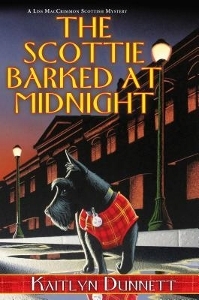Lea Wait's Blog, page 276
November 12, 2015
Pups, Prison, and a Day in the Life
Jen Blood here, taking a break from informing the masses about the trials of indie publishing to tackle another subject very close to my heart. In September of this year, I got a rare but exciting opportunity to run with the big dogs, in the big house. Yes indeed… The Maine State Prison, in Warren. And before anyone gets up in arms about referring to the inmates as dogs, relax – I really mean dogs. Of the cuddly, furry, four-legged (or three-legged, in one case) variety.
At this point, prison programs that partner inmates with shelter dogs to assist with training before the pups are placed in forever homes are not really news. They’ve been around for decades, starting with a program spearheaded by Sister Mary Quinn in 1981. Since that time, these programs have gotten a lot of attention in the press for their ability to teach real-life skills while simultaneously promoting compassion and community mindedness in a prison setting. Since Quinn started the movement, a multitude of similar programs have sprung up around the country, with both inmates and prison staff citing shifts in inmate behavior, a decrease in tension among the prison population, and enhanced social skills between both the humans and the dogs onsite.

Logan, one of the pups in the K-9 Corrections Prison Program when I visited in September.
I’ve been aware of such programs for a while now, beginning when I first sat in on a training session with K-9 Corrections back in 2008. K-9 Corrections is a program operated through the Pope Memorial Humane Society of Knox County, pairing shelter dogs with inmates at the Maine State Prison in Warren. The program is run by dog trainer Marie Finnegan, who was mentoring me back in ’08 when I was finishing a dog training certificate program with Animal Behavior College.
Back then, the program was limited to one or two dogs who lived onsite at Bolduc Correctional Facility, the minimum-security prison just down the road from the Maine State Prison. Just over two years ago, Finnegan and K-9 Corrections were invited into MSP after being on a brief hiatus due to staff changes at Bolduc.
According to Finnegan, she’s been pleased to see how the program has developed since making the switch. “These guys really care about the dogs…and because they care about the dogs, they get to know the other trainers in the program… It’s a great way for everyone to relate to each other and start to communicate in a positive way.”
While I was excited to sit in on the session in 2008, it had very little in common with participating in the session at the Warren “Supermax” in September. There were forms to fill out, metal detectors to go through, pens and phones were surrendered, and then there was what felt like a very long walk down an echoing corridor with Finnegan and Case Worker Martha Boynton by my side. We ultimately ended up at a building that houses inmates under less restrictive guidelines than the neighboring buildings on the campus. I signed in at the central desk and waited as inmates began to file in. Not just inmates, though. Inmates with dogs.
The day I was there, there were five dogs and eleven trainers in attendance. The dogs ranged from pups like feisty Logan and the little three-legged spitfire Olive, to an aged Boston terrier named Charlie whose battle scars attest to the tough life she’s endured before being taken in by the Humane Society. A sweet but shy guy named Archer and the lovely Luna (papa and mama to Olive and seven other pups when they first came to HSKC) rounded out the program. I stood back while the guys ran the dogs through their paces, consistently impressed with how in tune the trainers were with their charges.
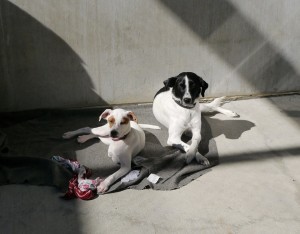
Olive and Archer — Archer is actually Olive’s dad. Here, I think you can definitely see a family resemblance.
When they come to the program, each dog is assigned a primary and secondary trainer. The dogs alternate between living and training with the primary and secondary trainers, which they do 24/7, sleeping in a crate in their cell, occasionally accompanying them to work or class, and then going out to exercise and work on training and socialization in the prison yard every day. Having a second trainer ensures that someone is always available if for any reason the other person on the team needs a break, works, or has an appointment where the dog isn’t able to come along.
Going through their paces, each training team that day would go up to the mat with their particular pup and demonstrate what they’d been working on for the week: sit, stay, down, come, and then a whole host of other tricks beyond the old standards, like twirl, moonwalk (you read that right), and wipe your paws (a tough one for Olive, who was born missing one of her front legs).
“People just take for granted that a dog can learn sit and stay,” says Finnegan, “even though some of those behaviors aren’t really that natural. But people assume a dog isn’t very smart unless he knows some tricks. Plus it’s good practice for the inmates to test their training chops.”
My favorite part of the afternoon comes when the training is done, however, and we’re able to go into the exercise yard. The yard looks much like a stereotypical prison yard you see in movies: concrete floor, concrete walls, a window too high up to reach, and a basketball hoop at one end. The dogs are able to go outside in the open air several times throughout the day, of course, but this yard is where the real fun is had, because it’s socialization time. Everyone is let off leash, and allowed to strut their stuff. Logan and Olive, the youngsters in the group, immediately race for one another and begin wrestling for all their worth. Archer, timid from the start, sticks close to his trainer, while Charlie — who hasn’t taken her eyes off her own trainer, Tom, since this session began — stays to the perimeter and Luna goes from person to person in search of treats and a little love.

Playtime in the yard with Olive, Archer, Logan, and Bobby, a pup added to the mix after my visit.
In the yard, I ask the guys one of the more obvious questions I can think of: How hard is it to say goodbye when the training is done?
“That’s the hardest part,” Tracy, Luna’s primary trainer, says immediately.
“It’ll just about break your heart,” agrees Tony, Logan’s primary. “Especially if there’s a lot of time before you get the next dog. Then your room just seems way too empty.”
“Do you think the program has changed you?” Marie asks the guys as we’re wrapping things up.
There is unanimous agreement, with the guys citing things like increased engagement, more tolerance, having a reason to get up every morning.
“It gives you a sense of humanity,” Ron tells me then. The others quiet a bit. Ron is Archer’s trainer – he’s a big, quiet man whose insight when it comes to his charge has impressed me from the start. “When I came here, there wasn’t much that got through to me. I was shut down. Then I started doing this, and all of a sudden something clicked.” The others in the yard seem to agree. “Having somebody rely on you everyday, give you that kind of love and look to you for what they need… That makes a difference.”
As we say our goodbyes, the trainers thank me for my time. The dogs are tired, their tails wagging as they make their way through the doors and back inside. Other inmates greet the weary pups with smiles. This is a dark place in a multitude of ways – I know that. It’s unlikely that the men who are here got here by stealing pies from someone’s kitchen window, after all. But it makes me feel a little bit better about the universe as a whole, that we as a society are coming to realize that some of the things that truly make a difference in our behavior and ability to engage with one another aren’t punishment and isolation… Positive interaction, clear expectations, compassion and contact and, yes, puppy dog tails, all really do go a long way in this world.
To learn more about the K-9 Corrections program, visit them on Facebook at http://facebook.com/K9Corrections/. Special thanks to Marie Finnegan for providing the photos in this post.
November 11, 2015
The Light of Day
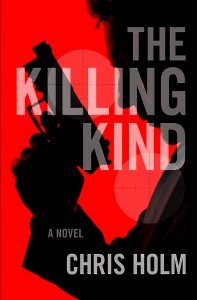 My god. November already. I confess, I’m not quite sure how that happened.
My god. November already. I confess, I’m not quite sure how that happened.
It’s been a month since last I posted here, and that month was an eventful one for me. THE KILLING KIND came out September 15. By October, it seemed as if the promotional cycle was winding down. Then, to my astonishment, Benjamin Percy of The New York Times Book Review weighed in with a doozy of a review. Here’s a taste of what he had to say:
As if that weren’t enough, the following week, The New York Times Book Review named THE KILLING KIND an Editor’s Choice. Nobody tell them, but I would’ve been delighted with an “Also out this month…” mention.
I’m grateful this book has struck a chord with readers, because there was a time when I wondered if it would ever see the light of day. In fact, come February 2013, I thought there was a chance my writing career was over.
I didn’t talk about it publicly at the time—in part because I’m not one to wallow in misfortune, and in part because I didn’t have the necessary perspective to do so without it coming off like sour grapes. But recently, the editor of The ITW’s The Thrill Begins, Ed Aymar, asked me if I’d share my story. He thought fellow authors might find it useful, and I agreed. You can read the piece I wrote for him here.
That piece was difficult for me to write, but I’m glad I did. Since it went live, I’ve spoken to loads of writers struggling through career setbacks and self-doubt who said it was exactly what they needed to hear. When I was down and out, my friends in the writing community helped pick me up and dust me off. The least I can do is try to pay that forward.
The fact is, I can’t guarantee your next project will be your breakout—but more importantly, you can’t guarantee it won’t… unless you never write it, that is.
All Those Years Ago
Bruce Robert Coffin here, taking a long look back . Several weeks ago, October 29th to be exact, my wife and I celebrated our thirtieth wedding anniversary. Thirty years! Why, it seems like only yesterday that the two of us met (almost 34 years ago). She a promising young cashier at a local supermarket (no longer there) and me an up and coming bagger of groceries. It was February and it was snowing. Our shift was nearing its end and the store was preparing to close (there were no twenty-four hour grocery stores back then). I was watching her walk outside to a row of shopping carriages, nestled up to the front wall of the building, right next to Bookland (also gone), when I made my move. She was looking plenty hot in her hunter orange cashier smock and name tag. I don’t recall exactly how I approached the subject of a date but I’m sure it was something suave and debonaire like: “Hey baby, what’s a nice girl like you doing in a place like this.” Anyway, whatever I said won her over because she said “yes.” And so we made a plan. Our first date was to be the night of the 15th. Yup that’s right, February 15th. Of course a smarter man would have shot for the 14th, Valentines Day, scoring a few points on the romantic front while simultaneously ensuring that if things worked out (and they have) I wouldn’t have to celebrate two days in February…
. Several weeks ago, October 29th to be exact, my wife and I celebrated our thirtieth wedding anniversary. Thirty years! Why, it seems like only yesterday that the two of us met (almost 34 years ago). She a promising young cashier at a local supermarket (no longer there) and me an up and coming bagger of groceries. It was February and it was snowing. Our shift was nearing its end and the store was preparing to close (there were no twenty-four hour grocery stores back then). I was watching her walk outside to a row of shopping carriages, nestled up to the front wall of the building, right next to Bookland (also gone), when I made my move. She was looking plenty hot in her hunter orange cashier smock and name tag. I don’t recall exactly how I approached the subject of a date but I’m sure it was something suave and debonaire like: “Hey baby, what’s a nice girl like you doing in a place like this.” Anyway, whatever I said won her over because she said “yes.” And so we made a plan. Our first date was to be the night of the 15th. Yup that’s right, February 15th. Of course a smarter man would have shot for the 14th, Valentines Day, scoring a few points on the romantic front while simultaneously ensuring that if things worked out (and they have) I wouldn’t have to celebrate two days in February…
The big night arrived. I picked her up at her house in South Portland. We were both dressed up and smiling, a lot. My stomach was in an absolute knot. We drove to The Jerry Lewis Theater (also gone, you might remember it as the more aptly named Maine Mall Cinema) where we attended a screening of the newest blockbuster, Indiana Jones, starring Harrison Ford. We shared some light hors d’oeuvres in the form of popcorn and soda, and I think this sly dog may have even slid an arm around her shoulders.
After the movie we drove to dinner, one parking lot over. I wanted her to experience the fine cuisine at the Maine Mall Pizza Hut (also gone). Yup, I know what you’re thinking, big spender. Hey, this guy knew how to live. To this day nothing beats the culinary delight of a pan pizza and an extra large Dr. Pepper. My wife tells a story of being horrified as she watched me swipe a piece of Pizza Hut silverware as a memento of our first date. Now, let me state unequivocally for the record that I have absolutely no recollection of said swiping. Hell, I went on to become a police officer, for crying out loud. She obviously has me confused with some other dashing young man she dated, with kleptomanical tendencies. Either way, since the statute of limitations on such a heinous crime has long since expired, if I had swiped said cutlery and given it to her as a first date keepsake, the fact that we are still together only speaks of her fondness for the “bad boys.” It would also have made her a co-conspirator and guilty of theft by receiving. Luckily nothing like the transgression for which I’m falsely accused actually took place. But I digress. Following a lovely dinner at Casa de Pizza, I drove her home where we “chatted” for a while before I bid her adieu. Promising to see her at work the following week.
Well, we’ve been seeing each other ever since. After a torrid three and a half year courtship (Hey, I never kiss and tell. You want details, wait for the book.), I asked for her hand in marriage. Again she said “yes.” Either I am extremely lucky or one sweet-talking son of a gun. Truthfully, I’m leaning toward lucky. We married in secret, on our only day off together, in the middle of the week, sneaking off to a JOP at a realtor’s office on Forest Avenue in Portland, next to the American Journal newspaper (Yup, you guessed it, both gone.) Our witnesses were two of the office staff, very nice ladies. I remember being so nervous they could have sold us a house and I wouldn’t have known it. We were dressed to the nines, her in a lovely flowered blouse and long dark skirt, me in tan slacks, button-down shirt with a tie, and my best navy blue polyester sport coat (The kind with the plastic buttons. Sharp.). We celebrated by dining at DiMillo’s Floating Restaurant, which, I’m happy to report, we didn’t put out of business (Steve, if you’re reading this, I swear to God there was no swiping of utensils). Afterward, we drove around visiting various relatives, informing them that we had gotten hitched.
Together we have travelled many miles since then, o’re hill and dale. We’ve shared the best and worse that life has to offer. Said goodbye to friends and loved-ones and welcomed new. We’ve struggled at times, prospered at others, but never have we quit. She is my best friend, my confidant, my lover, and my biggest fan. And I know she feels the same of me, because I am. This life is short, sometimes exhilarating, often hard, but it can be oh so sweet with the right companion, walking hand in hand beside you.
November 9, 2015
Six Lessons – Part One
By Brenda Buchanan
I’m writing this in early November, barely six months after launching my first novel, Quick Pivot, and a month after release of its sequel, Cover Story.
Amazingly enough, the third book in my Joe Gale Mystery Series, Truth Beat, already has been put to bed, as we say in the newspaper biz. Written, edited, proofed, gussied up with a beautiful cover to be revealed soon, Truth Beat is done.
Fini. Terminado. Críochnaithe.
Whew!
I’m now working on character sketches for my next book, one of my favorite parts of the process. I start with a few vague ideas about who will populate the story. I brainstorm names, backstories, genders, personalities, character flaws, then ruminate about these folks when not otherwise occupied. I dream about them, talk with them while driving (alone) and pretty soon I have a whole new community of imaginary friends with whom to share my life.
It occurred to me the other day that before I get too far along into the next book, it would be a good idea to take stock and share a few newfound insights. Here are the first three of six important lessons I have learned along the way. I’ll write about the other three in December.
Lesson #1: Make the Time. I could not have written three crime novels since 2008 if I didn’t write every day. At first, I didn’t appreciate the necessity of a routine. I thought I could only be productive if I had hours to sit down and immerse myself. I didn’t even try on days when I was busy, tired or uninspired.
It didn’t take long for me to realize this approach was unworkable. I have a rather demanding day job and numerous family and other commitments. If I didn’t make time to write, it wouldn’t happen. Creating a regular rhythm required me to transform the way I thought about my writing. Instead of it being something I might do after work, I decided to make it something I would do, no matter what kind of day I’d had and no matter what else was competing for my attention.
At first it felt rather grim, like rejoining the gym after a long absence, when your muscles ache after ten minutes on the Stairmaster and the acerbic voice in your head razzes you about how stupid it is to spend your time climbing imaginary stairs. Why are you wasting your energy? You don’t have time for this foolishness.
But I stuck with it. As with the gym, once I found my writing groove, I began to feel out of sorts if my routine was interrupted. It wasn’t always fun to park myself in front of the computer, but as time went on it felt good, in an odd sort of way.
Linear gal that I am, I started at the beginning and moved toward the end at a clip of two pages a night. I only deviated from this method when I found myself writing in circles or stepping on my own clues, which necessitated going backward only enough to get myself back on track. This dutiful approach resulted in a complete first draft, which at the time felt like more than half the battle. (It wasn’t, but the beauty of revision is a lesson for next month.)
I know that other writers take different approaches. Some write the last chapter first, or write in scenes, not chapters. I don’t think it matters how one goes about writing the book so long as there’s a regular routine to keep you engaged with the process, day in and day out.
Lesson #2: Create The Space. My decision to commit to my writing happened shortly after I moved from Peaks Island to the mainland. I put a desk in the part of our finished basement that the prior owners had used as an office and christened it Brenda’s Writing Cave. I stuck it out for maybe six months before realizing a subterranean space where I felt completely cut off from what was happening in the outside world was not for me.
Going to the other extreme, I set up shop in the den, which had the opposite drawback—it was in the middle of everything. Too close to the fridge and the TV, with a perfect view of the birdfeeders where something fascinating always was happening. So I moved my writing spot upstairs, which has proved to be the charm.
I am sitting in my “study” right now, which doubles as our guest room. It is quiet, especially in the cold weather months when the windows are closed. I have a bookcase for my stuff, and a beautiful photograph of the islands of Casco Bay above my desk.
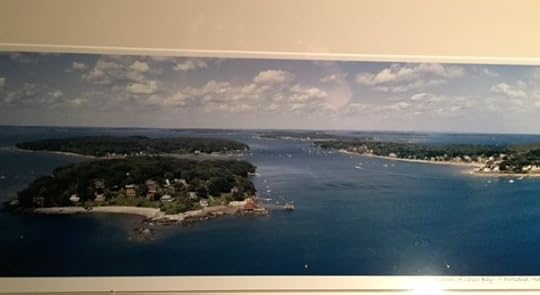
The photo of Casco Bay that hangs above my desk. Beautiful, and less distracting than a window.
I work here most of the time, though sometimes avail myself of the Sunday morning solitude of my unoccupied law office or seek out a quiet nook at one of several local libraries. No matter where I sit, water is at hand, occasionally coffee or tea. There are both pencils and pens within easy reach, and for reasons I can’t explain, a tube of lip balm is essential.

My desk, with pencils at the ready. The mugs feature my book covers, a gift from my thoughtful sister-in-law Chris Kenty.
I don’t snack while I write, or attempt to write with my laptop balanced on my knees. I need a desk or table and a reasonably comfortable chair.
I get down to business without detouring past email or social media. Like a diver swinging her arms before climbing the tall platform, I re-read the pages I wrote the previous day to warm my writerly muscles. Then I plunge in, and stay there until I’ve met my word goal for the day.
Having a comfortable, dedicated space to create maximizes the chance of uninterrupted work, and fewer interruptions mean greater productivity.
Lesson #3: Treasure those who love you.
No one does this alone. I knew that going in, but now I really know that.
While I’ve been busy writing, my spouse has managed our life. I still cook, but she does most everything else. Laundry. Cleaning. Gardening. Social calendar management. She helps me with writing-related tasks (like managing my mailing list) and is my first reader and the giver of much helpful feedback. She also sits in the front row at all of my speaking gigs.
This kind of active support is precious. As important—perhaps even more so—are her regular reminders to unplug from the intensity. We have a Sunday beach walk routine, no matter what the weather. We’re working our way through the eight seasons of Foyle’s War (how did we miss them when they were first aired?), and we swim every chance we get in the warm weather months. This counterweight to my every-day-I-must-write obsession is critical to my mental health.
I also am lucky to have a supportive group of friends, who I don’t see enough. We all have a lot going on in our lives, but for the past couple of years, I’ve too often been the one turning aside invitations, claiming not to have time to meet for dinner or go for a walk. Righting that particular imbalance is my goal for this winter, because life is too short to spend all my time with my imaginary friends when I am blessed with so many wonderful real ones.
Balance. It’s all about balance. How do you try to achieve that complex equilibrium? I am interested in your thoughts.
Stay tuned next month for lessons 4 through 6.
Want to get your book published? Start with a Crimebake
Hi all, Maureen here.
Sorry this is a little late this morning. Must still be recovering from this year’s excellent New England Crime Bake.
Some of you may be asking, “So, what’s a Crime Bake?” Eight years ago, I would have asked the same thing.

A Saturday morning panel at this year’s Crime Bake talks about the secrets to success. From left, Hallie Ephron, this year’s special guest Elizabeth George, Gayle Lynds, Peter Abrahams and moderator Ray Daniel, president of Mystery Writers of America, New England Chapter.
Back in 2008, I’d been intending for years to get a start on writing my first mystery novel. As many of you who have been in that position know, getting started can be the hardest part. I had a lot of “reasons” to stall, none of them very good. I knew that even then. But a big and very real issue — probably the biggest — was that I was in a total vacuum and had no idea really where to begin, how to get guidance along the way and what to do once it was done.
Since I didn’t know anyone who could help me with any of that, I decided to find people who could. That led me to the Mystery Writers of America, and through my googling and other research of that, led to my first Crime Bake, a weekend-long conference sponsored by the MWA New England Chapter and Sisters in Crime New England. I knew I desperately needed to go. I have never regretted that decision and haven’t missed one since. It is, seriously, my favorite weekend of the year.
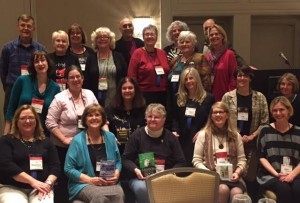
The 22 debut mystery novelists recognized at this year’s Crime Bake included me (Maureen Milliken) and fellow Maine Crime Writer blogger Brenda Buchanan.
That first year, I walked in Saturday morning (had to work Friday night) and found 250 people, many of whom were writing, wanted to write, or had written mystery novels. It was like an orphan finding the lost family she never knew she had. Not only was the sense of community more empowering that I ever could have predicted, but just knowing there were other people like me — and people successfully doing this! — was a huge step in getting me going, finally, on my own mystery novel.
I vowed at that Crime Bake to return to the next one with a finished manuscript I could pitch to an agent.
And now, here I was this weekend, eight Crime Bakes later, finally with a published book. I was one of 22 debut novelists at the event recognized this year. It was probably one of the highlights of my adult life. Or life, actually.
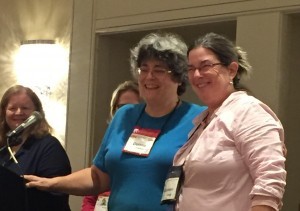
Mystery Writers of America Executive Vice President Donna Andrews presents me with a ribbon recognizing me as one of the 22 debut novelists at the 2015 New England Crime Bake.
It wasn’t a smooth road from that 2008 Crime Bake to being a published novelist at the 2015 event. A lot of factors, a lot lot lot of factors, went into finally getting that manuscript — which was just a few thousand words, jumbled ideas and going nowhere in 2008 — published. But I never, ever would have gotten where I am today if it weren’t for Crime Bake.
The advice (biggest takeway ALWAYS is to not give up), the guidelines for being professional and taken seriously, and the generous, supportive community are the foundation that I’ve built my mystery novelist career on.
I can’t stress enough to aspiring writers that the first step to getting unstuck and getting going is to find a Crime Bake and go to it. I highly recommend this one, even for people
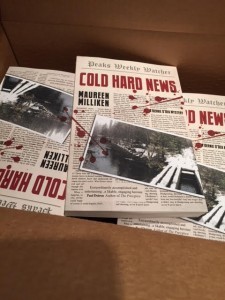
Look what I’ve got! Finally, at my 8th Crime Bake, I can say I’m a published author. And it feels pretty damn good.
who write in different genres, but there are conferences like it, big and small, all over the country all the time. Find the money and the time, go to it and learn.
And never look back. Thanks Crime Bake!
Maureen Milliken is the author of Cold Hard News, the first in the Bernie O’Dea mystery series. Follow her on twitter at @mmilliken47, on Facebook at Maureen Milliken Mysteries, and check our her website, maureenmilliken.com.
November 6, 2015
Weekend Update: November 7-8, 2015
 Next week at Maine Crime Writers there will be posts by Maureen Milliken (Monday), Brenda Buchanan (Tuesday), Bruce Coffin (Wednesday), Chris Holm (Thursday) and Jen Blood (Friday).
Next week at Maine Crime Writers there will be posts by Maureen Milliken (Monday), Brenda Buchanan (Tuesday), Bruce Coffin (Wednesday), Chris Holm (Thursday) and Jen Blood (Friday).
In the news department, here’s what’s happening with some of us who blog regularly at Maine Crime Writers:
from Kathy Lynn Emerson: There’s still time to win a copy of Murder in the Merchant’s Hall at Goodreads. The giveaway runs until November 9. Here’s the link: https://www.goodreads.com/book/show/26265846-murder-in-the-merchant-s-hall
from Kaitlyn Dunnett: The first book in the Liss MacCrimmon series is on sale in e-format during the month of November. It’s marked down to $1.99 for your Kindle, Nook, or iPad. Kensington Books, the publisher, is also reducing prices on other cozy mysteries in the near future, including some by fellow bloggers Barb and Lea.
This weekend, November 6-8, most of us (all of us??) will be at Crime Bake, a mystery convention in Dedham, Massachusetts, co-sponsored by Sisters in Crime of New England and Mystery Writers of America (New England).
An invitation to readers of this blog: Do you have news relating to Maine, Crime, or Writing? We’d love to hear from you. Just comment below to share.
And a reminder: If your library, school, or organization is looking for a speaker, we are often available to talk about the writing process, research, where we get our ideas, and other mysteries of the business. Contact Kate Flora: mailto: kateflora@gmail.com
November 5, 2015
Cats, Dogs, and Dastardly Deeds
Kaitlyn Dunnett here, hawking my new Liss MacCrimmon mystery, The Scottie Barked at Midnight, which has been out in hardcover and ebook formats for a whole week and a half now. In some ways, it was a challenge to write this one.
Dilemma: how to add dogs to a series that already has two cats.
Solution: keep them (mostly) separated.
In The Scottie Barked at Midnight, on a cold and bleak March evening, Liss MacCrimmon is driving home from a shopping spree at the outlets in Freeport, Maine when something darts in front of her car. Afraid that she’s hit a dog or a cat, she stops to look for the animal. What she finds, mercifully uninjured, is a lost and shivering Scottish terrier. She takes the little dog, a female, to the nearest vet and then agrees to keep her until the owner is found.
She did not consult her two cats, Lumpkin and Glenora. Needless to say, neither is thrilled to have a house guest. Fortunately, the Scottie, Dandy by name, is soon claimed. Not so fortunately, Dandy was running loose because she was dognapped, and returning her to her owner leads to Liss’s involvement in yet another murder.
Lumpkin and Glenora were on the cover of an earlier adventure, Scotched. For The Scottie Barked at Midnight, it is Dandy in the cover illustration. In fact, there are two Scotties in the story, Dandy and Dondi, two-thirds of an act called “Deidre and her Dancing Doggies” that is primed to win the top prize on a television variety show . . . until someone does in Deidre.
In need of another dancer to fill in for the murdered woman, Deidre’s daughter taps Liss. She was once a professional Scottish dancer, after all. How hard can it be for her to learn the steps to accompany two trained pups? In fact, it isn’t hard at all. The hard part is figuring out who killed Deidre and who is behind the dirty tricks haunting the competition, before that unscrupulous person can knock Liss out of the running, too.
Kaitlyn Dunnett/ Kathy Lynn Emerson is the author of over fifty books written under several names. She won the Agatha Award in 2008 for best mystery nonfiction for How to Write Killer Historical Mysteries and was an Agatha Award finalist in 2014 in the best mystery short story category for “The Blessing Witch.” Currently she writes the contemporary Liss MacCrimmon Mysteries (The Scottie Barked at Midnight) as Kaitlyn and the historical Mistress Jaffrey Mysteries as Kathy (Murder in the Merchant’s Hall). The latter series is a spin-off from her earlier “Face Down” series and is set in Elizabethan England. Her websites are www.KaitlynDunnett.com and www.KathyLynnEmerson.com
November 4, 2015
Yes! You are allowed to leave your desk
 Hi, it’s Kate Flora, and today I played hooky. With the holiday season approaching, and deadlines looming, it is hard to admit this, but yes, I left my desk, did not make my daily word count, and generally misbehaved. I didn’t read the two books I still need to finish for the panels I have to moderate at a conference this weekend, never mind the two about deadly force encounters and Decisive Force Response. I didn’t trying to knock down the next chapter in my latest nonfiction project, and I rudely stopped President Obama in the middle of his speech to the International Association of Chiefs of Police. Instead, I laced on my walking shoes (Goretex, North Face, courtesy of the Brunswick Salvation Army store) pulled on a sweatshirt (DKNY, Portland Goodwill), and headed out into a gorgeous fall day.
Hi, it’s Kate Flora, and today I played hooky. With the holiday season approaching, and deadlines looming, it is hard to admit this, but yes, I left my desk, did not make my daily word count, and generally misbehaved. I didn’t read the two books I still need to finish for the panels I have to moderate at a conference this weekend, never mind the two about deadly force encounters and Decisive Force Response. I didn’t trying to knock down the next chapter in my latest nonfiction project, and I rudely stopped President Obama in the middle of his speech to the International Association of Chiefs of Police. Instead, I laced on my walking shoes (Goretex, North Face, courtesy of the Brunswick Salvation Army store) pulled on a sweatshirt (DKNY, Portland Goodwill), and headed out into a gorgeous fall day.
 Sounds effortless, but in fact it wasn’t easy. When I give talks about the writing process, the word that comes right after imagination—the word that brings frowns to listener’s faces—is discipline. I am a firm believer in parking a certain too round part of my anatomy in my desk chair and staying there, for months or even years at a time, until my work is done. In my world, applying seat to seat goes hand in hand with the magic of storytelling, the fun of imagining a cast of characters, and the job of making that story work. But this morning, I was staring out at a deep red bush, a hydrangea with leaves going purple and bronze, and a tall maple still holding golden leaves, and remembering last February. Remember last February, when it seemed to snow every day? If this year is like last, there will be few walks except back down the newly shoveled path to make it wider.
Sounds effortless, but in fact it wasn’t easy. When I give talks about the writing process, the word that comes right after imagination—the word that brings frowns to listener’s faces—is discipline. I am a firm believer in parking a certain too round part of my anatomy in my desk chair and staying there, for months or even years at a time, until my work is done. In my world, applying seat to seat goes hand in hand with the magic of storytelling, the fun of imagining a cast of characters, and the job of making that story work. But this morning, I was staring out at a deep red bush, a hydrangea with leaves going purple and bronze, and a tall maple still holding golden leaves, and remembering last February. Remember last February, when it seemed to snow every day? If this year is like last, there will be few walks except back down the newly shoveled path to make it wider.
I decided to seize the day.
Is it odd, for someone whose job it is to notice the small details that make characters come  alive, to admit that I have to make myself go out into the world and look around? Sometimes I think so. But out I went and look I did. I noticed the nearly identical noses on the woman at the next table and her solicitous adult son sitting across from her. I was reminded that on a good day, the blue of an October sky is a startling color seemingly chosen from a palate of blues specifically to set off the autumnal golds and russets. I noticed how the habit of blowing leaves, rather than raking them, fills the world with noise pollution and a cloud of dust and dirt, and doesn’t release that earthy leaf smell that is so particular to fall. I was reminded of the many mushrooms that appear in the fall, including a particularly sinister one the size of a half bushel basket that is growing in my yard.
alive, to admit that I have to make myself go out into the world and look around? Sometimes I think so. But out I went and look I did. I noticed the nearly identical noses on the woman at the next table and her solicitous adult son sitting across from her. I was reminded that on a good day, the blue of an October sky is a startling color seemingly chosen from a palate of blues specifically to set off the autumnal golds and russets. I noticed how the habit of blowing leaves, rather than raking them, fills the world with noise pollution and a cloud of dust and dirt, and doesn’t release that earthy leaf smell that is so particular to fall. I was reminded of the many mushrooms that appear in the fall, including a particularly sinister one the size of a half bushel basket that is growing in my yard.
 I noticed that far from wearing their usual frowny faces or burying their noses in electronic devices, people were looking around, looking up, and smiling. That, alone, was worth leaving my desk for.
I noticed that far from wearing their usual frowny faces or burying their noses in electronic devices, people were looking around, looking up, and smiling. That, alone, was worth leaving my desk for.
The writing business is a peculiar one. We labor for months or perhaps years to create a work that then can take another year or more to go through the editing and publishing process before we reach a reader. It is an extreme exercise in delayed gratification. Going outside and taking in the world on a glorious fall day is instant gratification. So I’ve decided that today’s indulgence was okay.
Tomorrow I will pay the price for going out to play. It will be a long day at my desk. Writing questions for my panels. Getting the guestroom ready for company, and all the other tasks I ignored today.
But it was worth it.
Beyond Tipper and Leslie: Stuff you may not know about Maine

Dr. Clark loading up to go circuit riding
John Clark passing on some of the interesting stuff I’ve learned about Maine as an author and librarian. Maybe it’s old hat to some readers, but you never know when a piece of trivia might help your next book. Case in point: While writing a particular scene in Singing the L.A. Blues, I needed to be certain I set a fatal accident in Washington County’s portion of the Airline. Out came the trusty DeLorme Atlas and in a matter of thirty seconds, I had the setting right. I can’t tell you how many times that particular reference tool has been picked up while writing this young adult mystery. It helped create a fictional trail as well as locating a bog I needed for a psychic dream sequence. (more about this tool later).
Maine geography has always intrigued me, probably because of my family history on our father’s side. My grandfather, Arthur Hight Clark was probably the last circuit riding and barter dentist in the state. He had offices in the house in West New Portland, Bingham, Kingfield and Rangeley, spending a day per week in each location as well as stopping along the way to fly fish at every opportunity. Although he died when I was four, I heard endless tales of his travels and adventures from my father and grandmother including the time he was hunting and spotted what looked like a bear scuffling through the leaves in hardwoods below the ridge he was walking. Something didn’t look quite right, so he started sneaking down for a closer look. It turned out to be a very obese man on hands and knees, picking up beech nuts while wearing a fur coat. Gramps was also known to pull teeth and provide dentures in exchange for a cord of wood or some moose steaks.

Horatio Clark, several generations back
Stories like that, along with inheriting a collection of postal cancellations from towns long gone (many were from rail stops that had their own special cancellation stamp) as well as exploring places like Dallas Plantation, Chain of Ponds, etc. made Maine geography more than an academic subject for me as a ten year old kid. When I discovered The dictionary of Maine place-names, by Phillip R. Rutherford, published by Bond Wheelright in 1970, it fueled my fascination again as an adult. While many of the names it lists were derived from very common things, there are as many that came from far more interesting sources, especially Native American tribes. Having grown up at Sennebec Hill Farm and having been told that Sennebec was a corruption of the original Sunnybake the original people used to describe cooking fish on rocks when it was really hot was the sort of developmental push that kept me curious. This book is one of a few I really think are useful for writers interested in getting Maine right.
Another one that you can find in every town office as well as in Maine libraries is Tower Publishing’s Maine Register which is published annually. These are an extremely useful reference resource. Granted, much of what’s in it can be found online, but when you have one at hand looking things up is pretty snappy. It was one of my primary resources back when I taught Information Technology at Central Maine Community College. Here’s some of what you’ll find inside. There’s a mileage chart, U.S government data-our delegates, who sits on the federal court in Maine, which federal agencies have a presence in Maine and location/contact information, State government information including a list of notaries in Maine, Chambers of commerce, clubs, associations, societies and organizations grouped in categories like cultural and craft and special interest. Did you know that The American Poolplayers Association of Maine is headquartered in Lisbon Falls, or the Maine Gladiolus Society is located in East Vassalboro? Things like this are handy to know when you have those obscure Maine reference questions.
Perhaps the best part of the book is the data for every town and township in the state. Take Reed Plantation for example, it’s also known as Wytopitloc. The listing has things like who provides electrical service, who the pulpwood dealer is in town, the only listed commercial enterprise is Santa Claus Hill Christmas Trees, which school district serves the population, who the current municipal officers are and where to find the post office. Older editions go back to the 1850s and the 1855 edition is even available in digitized format thanks to the Hathi Trust at http://babel.hathitrust.org/cgi/pt?id=hvd.hb0l4e;view=1up;seq=13 I know much of what it contains IS online, but if you can snag a copy, I think you’ll find it worth your time. One thing the older editions get used for and used a lot is to verify whether a particular business existed at a particular time.
Now let’s talk about Gores. Back in the early days of our state (and apparently Vermont as well), surveyors missed small pieces of land. When these lost bits were later identified, they became known as gores. Maine has seven of them which I have listed here, Hibberts, Blake, Massachusetts, Coburn, Misery, Veazie and Gorham representing four counties. This can be a good trivia question to use at parties.

My father Robert Louis Clark in the famous Wheredaheckarewe Township
Another Maine geographic feature are the townships. Anyone who has traveled north of Bangor or up routes 201 or 27 has seen signs that have T.9, R.7 or something similar. Many of them have a two or three letter abbreviation after them. To learn what each of these stands for, the people responsible for a website called Maine-An Encyclopedia have put together a really good page that explains these. http://maineanencyclopedia.com/townships/
Another amazing website for anyone interested in Maine history and/or historic photographs is the Maine Memory Network, created and maintained by the Maine Historical Society in Portland. Hundreds of schools, local historical societies and individuals have spent thousands of hours identifying and uploading photos and documents to enrich the history of Maine. I used some of the knowledge I got while involved in a project with them and three local historical societies via a grant several years ago when I had Skye, the protagonist in my current book, doing research into cults in the early 1800s. Their site is here. https://www.mainememory.net/
Another ongoing and less well known digitization project is happening through the Raymond Fogler Library at the University of Maine in Orono. I became involved while at the Hartland Public Library when they put out a request for Maine libraries to help digitize town reports. Since then, it has expanded to include a lot more and is searchable by year and keyword. It’s another resource that could be extremely useful if you were writing historical mysteries or fiction set in Maine. Check it out here http://digitalcommons.library.umaine.edu/towndocs/
Here’s one last online guilty pleasure if you will. I used to read the Somerset police log online, but the newspaper that posted it, now limites non subscribers to ten articles a month and considerers this to be one (but not obituaries-go figure), so when Judy at the local post office told me about the new addition for Somerset County, I bookmarked it. Now a I can see who’s going down in flames with a couple clicks. I’m not sure whether any other counties are this advanced in profiling miscreants, but you can check out who is getting three hots and a cot in Skowhegan here http://www.somersetcounty-me.org/341/Media-Page
Finally, back to The DeLorme Atlas. No self-respecting Mainer should go forth without one. I have no interest in a GPS because this works just as well since 95% of my travels are in state. Browsing it is an interesting experience. Did you know there are three Slab Citys in Maine-Care to guess how they got their name? Sure, lots of the stuff in here is online, but when you’re trying to find the remote campground at Third Musquacook Lake and cell phone reception is -4 bars, I’ll take the atlas any day.

My late great uncle Leland who was equally adept at raising dinner plate dahlias and catching lunker togue
I’m curious about your finds and guilty pleasures when it comes to information sources.
November 2, 2015
How Are These Two Things the Same?
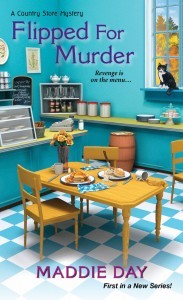 Hi. Barb here. Today my guest on the blog is Maddie Day, aka Edith Maxwell. Edith has visited before to talk about her Local Foods Mystery series. She’s a friend and fellow Kensington author and we also write together on the Wicked Cozy Authors blog.
Hi. Barb here. Today my guest on the blog is Maddie Day, aka Edith Maxwell. Edith has visited before to talk about her Local Foods Mystery series. She’s a friend and fellow Kensington author and we also write together on the Wicked Cozy Authors blog.
As Maddie Day, Edith has a new series out, the Country Store Mysteries, and the first book, Flipped for Murder, was just released. It’s set in southern Indiana, which makes Edith/Maddie the first Wicked to set a series outside New England. So I asked her to write about the regional differences. What is different and what is similar between a series set in Indiana and one set in Maine.
Take it away, Maddie!
Thanks for having me back on this great blog, Barb!
You remember those puzzles from when you were a child. Or maybe it was on the SAT test? Either way, how could Indiana possibly be compared to Maine?
 My new Country Store Mysteries series is set in southern Indiana, a part of the world I’m very fond of, where I spent five formative and glorious years – okay, part of them hungover – earning a PhD at Indiana University. I grew up on the west coast and am growing old on the opposite one, but there’s something very sweet about the middle of the country.
My new Country Store Mysteries series is set in southern Indiana, a part of the world I’m very fond of, where I spent five formative and glorious years – okay, part of them hungover – earning a PhD at Indiana University. I grew up on the west coast and am growing old on the opposite one, but there’s something very sweet about the middle of the country.
So I started thinking about things Maine and southern Indiana have in common.
 I could start with independent thinkers who live in the woods. Brown County, where I set the series, is hilly and pretty and looks a lot like New England, and harbors plenty of folks who’d rather be left to their own devices and opinions. I think that might be true of Maine, too.
I could start with independent thinkers who live in the woods. Brown County, where I set the series, is hilly and pretty and looks a lot like New England, and harbors plenty of folks who’d rather be left to their own devices and opinions. I think that might be true of Maine, too.
Then there’s colorful dialect. I’m not saying Mainers talk like Hoosiers, but they both retain a good number of regionalisms, both in pronunciation and expressions. Southern Indiana is really more Kentucky than Indiana, in my experience, and I’ve loved including phrases like, “That went faster than green grass through a goose,” “His drawer is all whopper-jawed,” and “Well, tie me to an anthill and fill my ears with jam!” I’m not personally acquainted with similar Maine phrases – other than ones from “Bert and I” sketches – but I’ll bet you hear them.
Both places traditionally eat a lot of potatoes, too. Am I stretching my luck here?

Maxwell Hall at Indiana University
What about an ocean, you say. All right. That’s in the category of How Are These Two Things NOT the Same. When I moved to Bloomington in 1977, I thought I would really miss the Pacific – so far the only ocean I knew – of which I was very fond and had grown up an hour’s drive away from. But you know, I didn’t really notice. When we wanted to cool off during our steamy grad school summers, we’d go swimming in a local reservoir or quarry. I still love the beach and the tangy smell of salt water, don’t get me wrong. I just did fine without it. Actually, it was during my time in grad school when I visited Maine for the first time, with a boyfriend who was from Kennebunkport and whose family had a house on Great Gott’s Island.
Readers: other similarities between Maine and Indiana, or any other midwestern state, that you know of?
About the book:
Flipped for Murder, the first book in the Country Store Mysteries series, releases October 27. The series features Robbie Jordan and Pans ‘N Pancakes, her country store restaurant in fictional South Lick, Indiana. When she remodels the store full of antique cookware and turns it into a local breakfast and lunch establishment, she doesn’t plan to have murder on the menu. But small-town secrets and bitter rivalries put sand in the batter and before Robbie knows it, her new life is a lot more complicated than she had expected.
Everyone in town shows up for the grand re-opening of the store, but when the mayor’s disagreeable assistant is found dead, Robbie realizes that not all press is good press. With all eyes on her, she’ll have to summon her puzzle-solving skills to clear her name, unscramble the town’s darkest secrets, and track down a cold-blooded killer–before she’s the next to die…
About Maddie Day

Edith Maxwell
Agatha-nominated and national best-selling author Edith Maxwell writes the Local Foods Mysteries and the Quaker Midwife Mysteries, the Country Store Mysteries (as Maddie Day), and the Lauren Rousseau Mysteries (as Tace Baker), as well as award-winning short crime fiction. Maxwell lives north of Boston with her beau and three cats, and blogs with the other Wicked Cozy Authors. You can also find her at www.edithmaxwell.com, @edithmaxwell, and on Facebook.
Lea Wait's Blog
- Lea Wait's profile
- 509 followers


